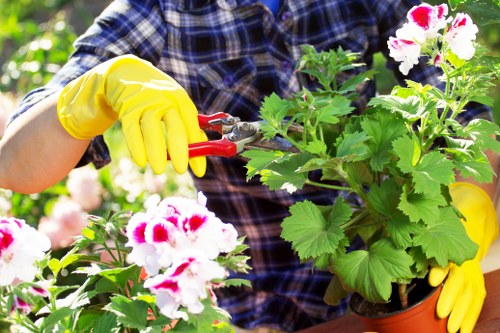Hedge Trimming in Belmont: Enhancing Your Garden’s Beauty

Hedge trimming is an essential aspect of garden maintenance, particularly in areas like Belmont where the climate and soil conditions require regular attention to keep plants healthy and aesthetically pleasing. Whether you’re a seasoned gardener or a homeowner looking to enhance your outdoor space, understanding the ins and outs of hedge trimming can make a significant difference in the appearance and health of your hedges.
Belmont residents take pride in their beautifully maintained gardens, and hedge trimming plays a pivotal role in achieving that goal. Properly trimmed hedges not only add structure and definition to your landscape but also promote the overall health of the plants by preventing diseases and encouraging robust growth.
In this comprehensive guide, we will explore the various aspects of hedge trimming in Belmont, including the best practices, tools required, seasonal considerations, and the benefits of professional services.

Why Hedge Trimming is Important
Regular hedge trimming is crucial for several reasons:
- Promotes Healthy Growth: Trimming encourages new growth and helps maintain the shape and size of the hedge.
- Prevents Diseases: Removing dead or diseased branches reduces the risk of pests and diseases spreading throughout the hedge.
- Enhances Appearance: Well-trimmed hedges enhance the overall look of your garden, adding structure and visual appeal.
- Improves Air Circulation: Proper trimming allows better air flow, which is essential for the health of the plants.
In Belmont, where gardens are a significant part of the community’s charm, maintaining lush and tidy hedges is a common practice among homeowners and landscapers alike.
Furthermore, regular trimming can extend the life of your hedges, ensuring they remain a vibrant and integral part of your outdoor space for years to come.

When to Trim Your Hedges
Timing is critical when it comes to hedge trimming. In Belmont, the best times to trim hedges are:
- Early Spring: Before the new growth begins, typically in March or April, to shape the hedge and remove any winter damage.
- Late Summer: Around August or September, to maintain the shape and encourage bushier growth before the colder months.
Avoid trimming during extreme weather conditions, such as the peak of summer or the depths of winter, as this can stress the plants and hinder their growth.
Additionally, some hedges benefit from an annual once-over, while others might require more frequent attention depending on their growth rate and the desired shape.

Essential Tools for Hedge Trimming
Having the right tools is essential for effective and safe hedge trimming. The following tools are recommended for maintaining hedges in Belmont:
- Pruning Shears: Ideal for small, precise cuts and shaping individual branches.
- Hedge Trimmers: Available in manual and electric versions, these are perfect for cutting larger sections quickly.
- Loppers: Useful for thicker branches that are beyond the capacity of standard pruning shears.
- Protective Gear: Includes gloves, safety glasses, and sturdy footwear to ensure safety during the trimming process.
- Measuring Tape: Helps in maintaining consistent hedge heights and ensuring uniformity.
Investing in high-quality tools not only makes the trimming process more efficient but also ensures that your hedges remain healthy and undamaged.
Regular maintenance of these tools, such as sharpening blades and cleaning, will extend their lifespan and maintain their effectiveness.

Step-by-Step Guide to Trimming Hedges
Following a systematic approach to hedge trimming ensures that the job is done correctly and efficiently. Here’s a step-by-step guide tailored for Belmont homeowners:
1. Assess the Health of Your Hedges
Before you begin trimming, inspect your hedges for any signs of disease, pests, or damage. Remove any dead or unhealthy branches to prevent further issues.
2. Plan Your Trim
Determine the desired shape and height of your hedges. Use a measuring tape to ensure consistency and mark any areas that need special attention.
3. Start with the Top
Begin trimming the top of the hedge first, working your way around it. This helps maintain an even shape and prevents over-trimming in one area.
4. Trim the Sides
Move on to the sides, using the top as a guide to maintain uniformity. Ensure that the sides are smooth and free of any jagged edges.
5. Clean Up
After trimming, clean up any debris to prevent pests and diseases from taking hold. Dispose of the clippings responsibly, either by composting or using green waste disposal services available in Belmont.
Tips for Effective Hedge Trimming
- Trim during dry weather to prevent the spread of diseases.
- Use sharp tools for clean cuts that heal quickly.
- Maintain a consistent trimming schedule to keep hedges looking their best.
- Consider professional help for large or intricate hedges.

Common Hedge Types in Belmont
Belmont boasts a variety of hedge types, each with its unique characteristics and maintenance needs:
Boxwood Hedges
Boxwood is a popular choice for formal gardens due to its dense foliage and ability to be shaped into precise forms. Regular trimming is essential to maintain its shape and prevent overgrowth.
Privet Hedges
Privet is known for its fast growth and versatility. It can be easily trimmed to create both formal and informal hedges, making it a favorite among Belmont gardeners.
Laurel Hedges
Laurel hedges are evergreen, providing year-round privacy and beauty. They require consistent trimming to keep them dense and well-shaped.
Holly Hedges
Holly offers a spiky texture and vibrant berries, adding both structure and color to gardens. Trimming helps manage their shape and promotes healthy growth.
Choosing the Right Hedge for Your Garden
When selecting a hedge type, consider factors such as growth rate, maintenance requirements, and the overall aesthetic you wish to achieve. Consulting with local Belmont nurseries can provide valuable insights into the best hedge options for your specific needs.

Benefits of Professional Hedge Trimming Services
While DIY hedge trimming can be satisfying, there are numerous benefits to hiring professional services in Belmont:
- Expertise: Professionals have the knowledge and experience to trim hedges correctly, ensuring optimal health and appearance.
- Time-Saving: Hiring experts frees up your time, allowing you to focus on other aspects of garden maintenance or personal activities.
- Safety: Professionals are trained to handle equipment safely, reducing the risk of accidents.
- Consistent Results: Regular professional trimming ensures that your hedges remain uniformly shaped and well-maintained.
In Belmont, numerous landscaping companies specialize in hedge trimming, offering tailored services to meet the unique requirements of your garden.
Additionally, professional services often include other landscaping maintenance tasks, providing a comprehensive solution for your outdoor space.
Choosing the Right Service Provider
When selecting a hedge trimming service, consider the following:
- Check for licenses and insurance to ensure legitimacy and protection.
- Read reviews and ask for references to gauge the quality of work.
- Compare quotes to find a service that fits your budget.
- Ensure that the company uses environmentally friendly practices, such as responsible disposal of green waste.

Seasonal Hedge Trimming Tips for Belmont
Different seasons require different approaches to hedge trimming to ensure that your plants thrive throughout the year:
Spring
Spring is an ideal time for a major trim, as it encourages fresh growth. Focus on shaping the hedge and removing any damaged branches from the winter months.
Summer
In the heat of summer, lighter trims can help maintain the shape and prevent the hedge from becoming overgrown. Water regularly to support healthy growth during this period.
Autumn
Autumn trims help prepare hedges for the colder months. Remove any excess growth and ensure that the hedge is tidy before winter sets in.
Winter
Avoid heavy trimming during winter, as the cold can stress the plants. However, removing any dead or diseased branches is still recommended.
Protecting Your Hedges Year-Round
Implementing seasonal trimming strategies ensures that your hedges remain healthy and visually appealing throughout the year. By adapting your trimming practices to the changing seasons, you can address specific growth patterns and environmental challenges unique to each period.

Eco-Friendly Practices in Hedge Trimming
Adopting eco-friendly practices in hedge trimming not only benefits your garden but also the environment. Here are some sustainable practices to consider:
- Composting: Compost your green waste to create nutrient-rich soil for your garden.
- Mulching: Use hedge trimmings as mulch to retain soil moisture and suppress weeds.
- Proper Disposal: If composting isn’t an option, use local green waste disposal services available in Belmont.
- Electric Tools: Opt for electric hedge trimmers over gas-powered ones to reduce emissions.
- Native Plants: Incorporate native plant species that require less water and maintenance.
By integrating these practices, you contribute to a healthier ecosystem and promote sustainable gardening in your community.
Additionally, reducing the use of chemicals and promoting natural growth methods can enhance the biodiversity of your garden, attracting beneficial insects and wildlife.

Common Mistakes to Avoid
Even with the best intentions, improper hedge trimming can lead to several problems. Here are common mistakes to avoid:
Over-Trimming
Removing too much of the hedge can stress the plants, making them more susceptible to diseases and pests. Always trim conservatively, especially if you’re unsure about the appropriate amount.
Incorrect Timing
Trimming at the wrong time of year can hinder growth or expose hedges to unnecessary stress. Follow seasonal guidelines to ensure optimal results.
Using Dull Tools
Dull tools can cause ragged cuts, which take longer to heal and can become entry points for pathogens. Regularly sharpen your tools to maintain clean cuts.
Ignoring Plant Health
Failing to inspect hedges for signs of disease or pests before trimming can exacerbate existing issues. Address any health concerns prior to trimming to ensure the overall well-being of your plants.
Maintaining Consistency
Inconsistent trimming can lead to uneven growth and an unbalanced appearance. Use measuring tools and follow a consistent trimming schedule to maintain uniformity.
Cost of Hedge Trimming Services in Belmont
The cost of professional hedge trimming services in Belmont can vary based on several factors:
- Size of the Hedge: Larger hedges require more time and resources, increasing the overall cost.
- Type of Hedge: Some hedge types are more labor-intensive to trim due to their growth patterns and density.
- Frequency of Service: Regular maintenance plans may offer discounts compared to one-time services.
- Additional Services: Services such as hedge shaping, health assessments, and disposal of green waste can affect the price.
On average, homeowners in Belmont can expect to pay between $50 to $150 per hour for professional hedge trimming services, depending on the specific requirements of their garden.
Getting multiple quotes and comparing services can help you find a provider that offers the best value for your needs.
Investing in Quality
While cost is an important factor, prioritizing quality ensures that your hedges are maintained properly and continue to thrive. Investing in reputable services with positive reviews can lead to long-term benefits for your garden.
Maintaining Your Tools
Proper maintenance of your hedge trimming tools ensures their longevity and effectiveness. Here are some maintenance tips:
- Cleaning: Remove any debris and sap from the blades after each use to prevent rust and maintain sharpness.
- Sharpening: Regularly sharpen blades to ensure clean cuts and reduce the strain on the plants.
- Lubrication: Apply oil to moving parts to keep them functioning smoothly.
- Storage: Store tools in a dry, sheltered place to protect them from the elements.
- Inspection: Periodically check for any signs of wear or damage and repair or replace parts as needed.
Taking the time to maintain your tools not only improves their performance but also ensures that your hedge trimming tasks are completed efficiently and safely.
Additionally, well-maintained tools reduce the risk of accidents, making your gardening experience more enjoyable and stress-free.
DIY Hedge Trimming vs. Professional Services
Deciding whether to trim your hedges yourself or hire professionals depends on various factors:
DIY Hedge Trimming
Pros:
- Cost Savings: Eliminates labor costs associated with hiring professionals.
- Flexibility: Allows you to trim at your convenience.
- Personal Satisfaction: Provides a sense of accomplishment and control over your garden.
Cons:
- Time-Consuming: Can be labor-intensive, especially for large or dense hedges.
- Skill Requirement: Requires knowledge and experience to achieve professional results.
- Safety Risks: Potential for accidents if proper safety measures are not followed.
Professional Hedge Trimming
Pros:
- Expertise: Professionals bring knowledge and experience, ensuring high-quality trims.
- Efficiency: Can complete the job faster and more effectively than DIY.
- Safety: Reduces the risk of accidents with trained personnel and proper equipment.
Cons:
- Cost: Higher upfront expenses compared to DIY.
- Scheduling: Requires coordinating with service providers for appointments.
- Less Control: Relinquishes some control over the specific trimming details.
Making the Right Choice
Consider your budget, the size and complexity of your hedges, and your personal comfort level with gardening tasks when deciding between DIY and professional services. For intricate or extensive hedge trimming needs, hiring professionals in Belmont may provide the best results.
Enhancing Curb Appeal with Well-Trimmed Hedges
Well-trimmed hedges significantly enhance the curb appeal of your home. In Belmont, where neighborhood aesthetics are valued, maintaining pristine hedges can make your property stand out.
Strategically placed and neatly trimmed hedges can create natural boundaries, define garden spaces, and add depth to your landscape design. They also serve practical purposes, such as providing privacy and reducing noise from nearby roads or neighbors.
Moreover, healthy and vibrant hedges contribute to the overall health of your garden ecosystem, supporting biodiversity by providing habitats for beneficial insects and birds.
Creative Hedge Designs
Beyond traditional shapes, consider creative designs for a unique garden look:
- Topiary Shapes: Shaped into animals, geometric forms, or abstract patterns for an artistic touch.
- Layered Hedges: Combining different hedge types at varying heights for a dynamic appearance.
- Mixed Shrub Hedges: Incorporating a variety of shrub species to add texture and color diversity.
Collaborate with professional landscapers in Belmont to explore innovative hedge design options that complement your home’s architectural style and your personal preferences.
Conclusion: Invest in Quality Hedge Trimming
Hedge trimming is a vital component of garden maintenance in Belmont, offering numerous benefits that enhance both the health of your plants and the beauty of your outdoor space. Whether you choose to undertake the task yourself or hire professional services, investing time and resources into proper hedge trimming will yield long-term rewards.
By understanding the best practices, utilizing the right tools, and adhering to seasonal guidelines, you can maintain lush, vibrant hedges that contribute to the overall appeal and functionality of your garden.
For those seeking expert assistance, professional hedge trimming services in Belmont provide the expertise and efficiency needed to keep your hedges in pristine condition.
Contact us today to learn more about our hedge trimming services and take the first step towards a more beautiful and healthy garden.
